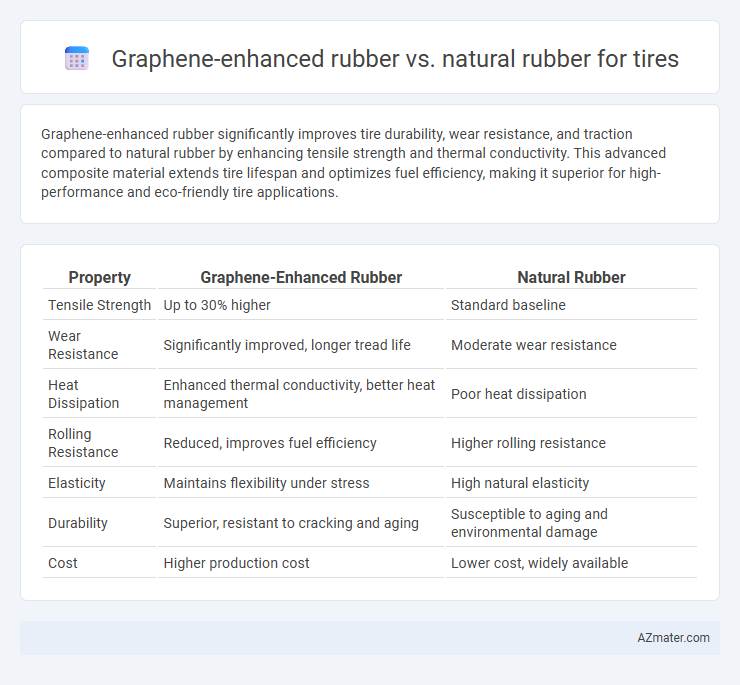Graphene-enhanced rubber significantly improves tire durability, wear resistance, and traction compared to natural rubber by enhancing tensile strength and thermal conductivity. This advanced composite material extends tire lifespan and optimizes fuel efficiency, making it superior for high-performance and eco-friendly tire applications.
Table of Comparison
| Property | Graphene-Enhanced Rubber | Natural Rubber |
|---|---|---|
| Tensile Strength | Up to 30% higher | Standard baseline |
| Wear Resistance | Significantly improved, longer tread life | Moderate wear resistance |
| Heat Dissipation | Enhanced thermal conductivity, better heat management | Poor heat dissipation |
| Rolling Resistance | Reduced, improves fuel efficiency | Higher rolling resistance |
| Elasticity | Maintains flexibility under stress | High natural elasticity |
| Durability | Superior, resistant to cracking and aging | Susceptible to aging and environmental damage |
| Cost | Higher production cost | Lower cost, widely available |
Introduction to Rubber Materials in Tire Manufacturing
Graphene-enhanced rubber offers significantly improved mechanical strength, thermal conductivity, and wear resistance compared to natural rubber, making it a breakthrough material in tire manufacturing. Natural rubber, derived from latex of rubber trees, provides excellent elasticity and resilience but lacks the durability and heat management properties essential for high-performance tires. Integrating graphene into rubber compounds optimizes tire longevity, fuel efficiency, and safety by enhancing tread life and reducing rolling resistance.
What is Graphene-Enhanced Rubber?
Graphene-enhanced rubber is a composite material that incorporates graphene, a single layer of carbon atoms arranged in a hexagonal lattice, into natural rubber to significantly improve its mechanical properties. This innovative material enhances tire performance by increasing durability, abrasion resistance, and tensile strength while also reducing weight and rolling resistance. Compared to natural rubber, graphene-enhanced rubber offers superior heat dissipation and longevity, leading to improved fuel efficiency and longer tire lifespan.
Properties of Natural Rubber in Tire Applications
Natural rubber offers excellent elasticity, resilience, and abrasion resistance, making it a preferred material for tire manufacturing. Its high tensile strength and flexibility contribute to superior traction and durability under varying road conditions. The biopolymer's natural damping properties also provide enhanced shock absorption and ride comfort in tire applications.
Durability: Graphene-Enhanced vs Natural Rubber
Graphene-enhanced rubber exhibits significantly higher durability compared to natural rubber due to its exceptional tensile strength and resistance to wear and tear. The integration of graphene nanosheets improves elasticity and reduces cracks and abrasion in tires, resulting in longer tread life and enhanced performance under varying road conditions. Studies show graphene-enhanced tires can achieve up to 50% greater lifespan and maintain structural integrity better than traditional natural rubber formulations.
Performance and Traction Comparison
Graphene-enhanced rubber significantly outperforms natural rubber in tire applications by providing superior tensile strength, improved abrasion resistance, and enhanced thermal conductivity, which reduces heat buildup during high-speed driving. This advanced composite material delivers better traction on wet and dry surfaces through increased grip and elasticity, directly contributing to shorter braking distances and enhanced cornering stability. The integration of graphene also boosts the tire's longevity by minimizing wear and tear, offering a performance edge in both everyday and demanding driving conditions.
Environmental Impact and Sustainability
Graphene-enhanced rubber significantly reduces tire wear and rolling resistance, leading to lower fuel consumption and decreased carbon emissions compared to natural rubber. The enhanced durability of graphene-infused tires extends lifespan, minimizing waste and raw material demand, contributing to more sustainable tire production. Natural rubber involves extensive land use and deforestation risks, while graphene composites incorporate advanced materials to mitigate environmental footprint without sacrificing performance.
Cost Analysis: Production and Lifecycle
Graphene-enhanced rubber exhibits higher initial production costs compared to natural rubber due to advanced material synthesis and integration processes. However, its improved durability and wear resistance significantly extend tire lifecycle, reducing replacement frequency and overall maintenance expenses. Lifecycle cost analysis reveals that despite upfront investment, graphene-enhanced tires offer superior long-term economic benefits through enhanced performance and lower total cost of ownership.
Safety Aspects and Real-World Testing
Graphene-enhanced rubber exhibits superior abrasion resistance, heat dissipation, and puncture resistance compared to natural rubber, significantly enhancing tire safety under extreme driving conditions. Real-world testing demonstrates improved grip and shorter braking distances on wet and dry surfaces, reducing accident risk. Sensors integrated within graphene composite tires also provide real-time performance monitoring, further contributing to driver safety.
Market Adoption and Future Trends
Graphene-enhanced rubber is gaining traction in the tire industry due to its superior strength, durability, and heat resistance compared to natural rubber, leading to increased market adoption by premium tire manufacturers. Recent market reports project a CAGR of over 15% for graphene-enhanced rubber in automotive applications by 2030, driven by growing demand for high-performance tires and sustainability goals. Future trends indicate continued integration of graphene nanomaterials to improve tire wear resistance and fuel efficiency, positioning it as a key innovation disrupting the traditional natural rubber tire market.
Conclusion: Which Rubber is Best for Tires?
Graphene-enhanced rubber offers superior tensile strength, increased wear resistance, and better thermal conductivity compared to natural rubber, leading to longer tire life and improved fuel efficiency. Natural rubber, however, provides excellent elasticity, resilience, and cost-effectiveness, making it suitable for standard tire applications. For high-performance tires requiring durability and enhanced safety, graphene-enhanced rubber is the best choice, while natural rubber remains optimal for general-purpose tires due to its balance of properties and affordability.

Infographic: Graphene-enhanced rubber vs Natural rubber for Tire
 azmater.com
azmater.com